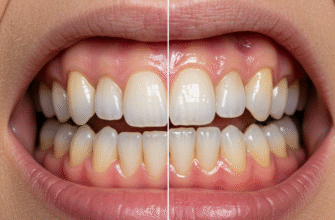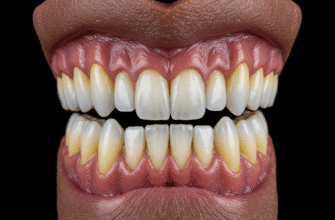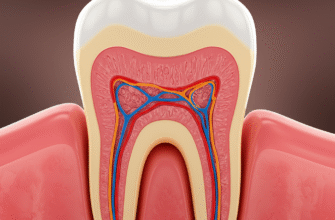Many of us have experienced it: a little pink in the sink after brushing or flossing. For some, it is such a common occurrence that it barely registers. “Oh, it is just a little bit of blood,” we might think, “it happens.” This casual acceptance of bleeding gums is a widespread misconception, a myth that has unfortunately taken root in our collective understanding of oral health. But let us be clear: healthy gums do not bleed. Not even “a little bit.” Thinking that a touch of blood is normal is like assuming a smoke alarm chirping faintly now and then is just part of its regular operation. It is a signal, and one that deserves our attention.
The idea that minor gum bleeding is par for the course probably stems from how frequently it can occur if oral hygiene is not quite up to scratch. Because it is seen often, it is mistakenly labeled as “normal.” However, frequency does not equate to normalcy or, more importantly, to health. Our gums are designed to be resilient, a protective barrier for our teeth and an integral part of our overall well being. When they bleed, they are sending out an SOS, indicating that something is not right within that delicate oral environment.
Understanding the “Why” Behind Bleeding Gums
So, if it is not normal, why do gums bleed? The most common culprit is a condition many have heard of: gingivitis. This is the earliest stage of gum disease, and it is essentially an inflammation of the gums. Think of it like this: tiny food particles and bacteria in our mouths are constantly trying to set up camp on our teeth. If we do not effectively remove them through regular and proper brushing and flossing, they form a sticky, invisible film called plaque.
This plaque is like a bustling city for bacteria. These bacteria produce toxins that irritate the gums. Your gums, in response to this unwelcome invasion and irritation, become inflamed. Inflamed tissues are often swollen, tender, and, crucially, more prone to bleeding. When you brush or floss, even gently, these irritated and engorged blood vessels in the gums can easily rupture, leading to that telltale pink or red in your saliva. It is your body’s way of saying, “Hey, there is an issue here, and I am trying to fight it, but I need some help!”
Beyond gingivitis, there are a few other reasons your gums might bleed:
- Overly enthusiastic oral care: Sometimes, in our zeal to get our teeth sparkling clean, we might brush too hard or use a toothbrush with bristles that are too stiff. This aggressive approach can physically traumatize the gum tissue, causing it to bleed. It is a bit like scrubbing a delicate fabric with a wire brush – you will cause damage.
- New to the flossing game: If you have recently started flossing (good on you!), you might notice some bleeding initially. This is often because the gums are not used to the stimulation, and there might already be some underlying inflammation from plaque that the floss is now disturbing. This type of bleeding should typically subside within a week or two of consistent, gentle flossing. If it does not, it is a sign of a more persistent issue.
- Certain lifestyle factors: Things like smoking can significantly impact gum health, making them more susceptible to problems, including bleeding. Nutritional considerations can also play a role, as can hormonal fluctuations, for example, during pregnancy.
- Some medications: A few medications can have side effects that include increased gum bleeding. If you suspect this, it is a conversation to have with your doctor or dentist; never stop medication without professional advice.
The key takeaway is that bleeding is a symptom, not a standalone event. It is a reaction to something, most commonly plaque buildup and the resulting inflammation.
“Just a Little Bit” is Still a Big Deal
Let us revisit that phrase: “just a little bit.” Imagine if another part of your body, say your scalp, bled a little bit every time you washed your hair. Or if your hands bled slightly every time you washed them. Would you dismiss it as normal? Unlikely. You would probably be concerned and seek to understand why it was happening. Our gums deserve the same level of attention and care.
The “little bit” of blood is an early warning sign. It is the check engine light of your mouth. Ignoring it because it seems minor is like putting a piece of tape over that dashboard light and hoping the problem goes away on its own. Unfortunately, dental issues rarely resolve themselves without intervention. That small sign today can be an indicator of a more significant problem brewing beneath the surface.
Important Reminder: Persistent gum bleeding, even if it seems minor, is a signal from your body that something needs attention. Ignoring it can allow minor issues to develop into more serious oral health problems. Healthy gums typically do not bleed with routine care.
The Slippery Slope: Consequences of Unchecked Gum Bleeding
What happens if we consistently ignore that pink in the sink? If the underlying cause, usually gingivitis, is not addressed, it can progress. Think of gingivitis as the opening act; the main event, if left unchecked, is a more serious condition called periodontitis.
Periodontitis is a more advanced stage of gum disease where the inflammation spreads deeper, affecting the tissues and bone that support your teeth. The gums can start to pull away from the teeth, forming pockets. These pockets become perfect hideouts for even more bacteria, making them harder to clean and allowing the infection to worsen. As the supporting bone is lost, teeth can become loose and, in severe cases, may eventually need to be removed or can even fall out. This is not meant to scare, but to illustrate the potential long-term consequences of what might start as “just a little bleeding.”
Beyond the risk of tooth loss, ongoing gum inflammation can contribute to other less-than-pleasant issues:
- Persistent bad breath (halitosis): The bacteria thriving in inflamed gums and plaque produce volatile sulfur compounds, which are notorious for causing bad breath that mints and mouthwash often only mask temporarily.
- Gum recession: As gums become unhealthy, they can recede, exposing more of the tooth root. This can lead to sensitivity and change the appearance of your smile.
- Discomfort and pain: While early gingivitis might just cause bleeding, as gum problems worsen, they can lead to sore, swollen, and painful gums, making eating and even speaking uncomfortable.
The health of our mouth is also increasingly understood to be connected to our overall health. While this article will not delve into complex medical links, maintaining good oral hygiene, which includes addressing bleeding gums, is a fundamental part of looking after ourselves.
Taking Action: Steps Towards Healthier Gums
The good news is that in many cases, especially when caught early, bleeding gums due to gingivitis can be reversed with improved oral hygiene and professional care. Here is how you can take proactive steps:
Revamp Your Oral Hygiene Routine
This is your first line of defense and attack.
- Brush Better, Not Harder: Use a soft-bristled toothbrush. Angle the bristles at about 45 degrees towards the gumline. Use gentle, short, circular or back-and-forth strokes. Do not scrub aggressively. Aim to brush for at least two minutes, twice a day. Consider an electric toothbrush, as many have pressure sensors and timers that can help improve technique.
- Embrace Flossing (Correctly): Flossing is crucial for cleaning between teeth and under the gumline where your toothbrush cannot reach. Use about 18 inches of floss, wind most of it around one middle finger, and the rest around the other. Gently guide the floss between your teeth using a rubbing motion. Curve it into a C-shape against one tooth, and slide it gently beneath the gumline. Repeat for the adjacent tooth. Do not snap the floss down onto your gums. If you are new to flossing, expect some initial bleeding that should stop within a week or two. If it persists, consult your dentist.
- Consider an Antiseptic Mouthwash: After brushing and flossing, an over-the-counter antiseptic or anti-gingivitis mouthwash can help reduce bacteria and freshen breath. Look for ones with proven ingredients. However, mouthwash is an adjunct to, not a replacement for, brushing and flossing.
Don’t Skip Your Dental Check-ups
Regular visits to your dentist and dental hygienist are paramount. They can:
- Perform Professional Cleanings: They can remove hardened plaque (tartar or calculus) that you cannot remove at home with brushing and flossing. Tartar buildup is a major contributor to gum inflammation.
- Identify Early Signs: Dental professionals are trained to spot the early signs of gum issues, often before you might notice significant symptoms yourself.
- Provide Personalized Advice: They can assess your specific situation, demonstrate proper cleaning techniques, and recommend products tailored to your needs.
Lifestyle Considerations for Gum Health
General healthy habits can also support your oral health:
- Nutritious Diet: A balanced diet rich in vitamins and minerals supports overall health, including your gums. For example, Vitamin C is important for collagen production, a key component of gum tissue.
- Avoid Tobacco: Smoking and tobacco use are major risk factors for gum disease and can hinder healing. Quitting can significantly improve your gum health outlook.
When to Monitor, But Not Panic (Immediately)
While we have established that consistent bleeding is not normal, there are a couple of very specific, temporary scenarios where a little bleeding might occur without immediate alarm, though it always warrants observation:
- Starting a New Flossing Routine: As mentioned, if you have not flossed regularly, your gums might be slightly inflamed due to plaque buildup between teeth. Introducing floss can initially cause some bleeding as you disturb this plaque and stimulate the gums. This should resolve within 7 to 14 days of consistent, gentle flossing. If it continues beyond this period, it is a sign of underlying gingivitis that needs addressing.
- A New, Stiffer Toothbrush or Aggressive Brushing: If you have switched to a much harder toothbrush or are uncharacteristically brushing with a lot of force, you might cause minor trauma and bleeding. Switching back to a soft brush and using gentle pressure should stop this almost immediately. If bleeding persists even with a soft brush and gentle technique, look to other causes.
In these limited instances, the bleeding is usually a direct, temporary result of a change in routine or mild trauma. However, persistent bleeding is never normal, regardless of the perceived cause.
The Bottom Line: Healthy Gums Don’t Bleed
The myth that a little bit of gum bleeding is normal is a dangerous one because it encourages complacency. Bleeding gums are a clear sign that your gums are inflamed and unhappy, most often due to the presence of plaque bacteria. It is an early distress signal that, if heeded, can help you prevent more serious oral health problems down the line, including advanced gum disease and potential tooth loss.
Instead of dismissing that pink in the sink, see it as an opportunity. It is a call to action to evaluate and potentially improve your oral hygiene habits. Brush gently but thoroughly, make flossing a non-negotiable part of your daily routine, and maintain regular visits with your dental professionals. By understanding that bleeding gums are a symptom, not a normality, you empower yourself to take control of your oral health, ensuring your smile stays healthy and strong for years to come. Do not let a “little bit” of bleeding turn into a big problem. Your gums will thank you for it.








